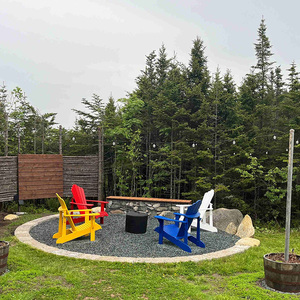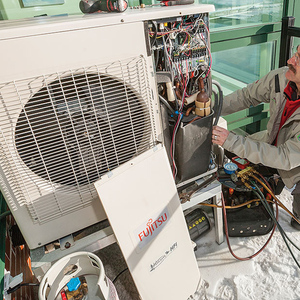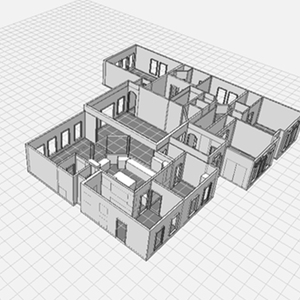While I was doing some work at a customers house, she casually asked me if I would take a look at a broken “beam” in the garage.
Here’s what I found:
Here’s the garage roof. You can see the significant sag that has occurred over the 75-year life span of this garage. There’s also an outward bow in the walls, but you can’t see that in the picture.
There is no ridge beam in the garage so these “trusses” are pretty important. There’s only 3 of them and they’re just 2X4’s nailed together. None of the 2X4’s span the width of the garage, but they have a little more overlap than this one.
I’m planning on jacking up the truss without actually lifting the roof and replacing the bottom chord with a 2X6 overlapping at least 6′ and bolting everything together. I haven’t decided if I should replace any other parts of this “truss system”, but I don’t think I will since it took 75 years to get to this point. I figure my repair should just stabilize things in their current sagging state.



















Replies
>>>There's only 3 of them and they're just 2X4's nailed together.
Scary.
I've seen many garages similarly constructed.
As I stood before the gates I realized that I never want to be as certain about anything as were the people who built this place. --Rabbi Sheila Peltz, on her visit to Auschwitz
Obviously the problem was caused by that bike hook. ;)
The relatively "fresh" wood in the upper split indicates that that split is fairly recent. It appears to be due to force from the nails, but can't tell if the nails in question were the ones holding the diagonals, or the ones splicing the two horizontals.
If it was only the splits at a horizontal joint it would be a simple matter to thru-bolt things together, and if only near the diagonal you could just sister a piece. But with the combo you probably do need to replace the right-hand piece with one a foot or two longer, to gain overlap with the left-hand piece.
I'd probably try to jack the above rafter an inch or so before disassembling, and I might consider using a come-along horizontally to take the tension off as well. Not trying to recover all the sag, but address what has occurred as a result of the split, and also compensate for the stretch that will occur on the new joint once supports are removed.
> Obviously the problem was caused by that bike hook. ;)On second thought, I'm guessing someone tried to unload a lathe from a truck using a chain hoist. ;) ;)
As I stood before the gates I realized that I never want to be as certain about anything as were the people who built this place. --Rabbi Sheila Peltz, on her visit to Auschwitz
"I'm guessing someone tried to unload a lathe from a truck using a chain hoist."
Now THAT was funny. Best laugh I've had all day.
(-:
Last night I saw my parents having sex. I'm never gonna visit THAT website again. [Larry the cable guy]
Why not repair the entire thing, sag and bow and all, rather than patch a botched job? If it falls down, you and your "repair" will be accused of causing the damage.
Fix it. Tell the customer the problem, and the solution and tender a bid for the repair.
It's not a "botched job". It was perfectly adequate for 70 years or so. The type of construction is "standard" and the roof sag is "normal" for a garage of that era.Mucking with it too much risks causing other joints to fail, and I doubt that the owner is anxious to replace the entire roof.But of course the owner should be consulted and given the option of having the sag corrected (though she should be told it would be opening a can of worms).
As I stood before the gates I realized that I never want to be as certain about anything as were the people who built this place. --Rabbi Sheila Peltz, on her visit to Auschwitz
That is not any kind of a truss I have ever seen. It is all stick framing inadequately stitched together. Looks like the span for sheathing is gross too
It also shows a hook screwed in where apparently some yokel tried to lift something heavy.
I would only take this job on if she agree to let me fix the whole thing to modern (my) standards, knowing that as soon as you touch it, the liability is yours
Welcome to the
Taunton University of Knowledge FHB Campus at Breaktime.
where ...
Excellence is its own reward!
I'm with you on this one. Appears to be a very inadequate structured garage!
Add two more hand made trusses on either side of the broken one. Use plywood gussets, W pattern and PL premium. That should hold up the roof.You get out of life what you put into it......minus taxes.
Marv
It also shows a hook screwed in where apparently some yokel tried to lift something heavy.
I saw that hook, but I assumed it was for a bicycle, but maybe not. The HO did tell me that the landscapers were up on the roof cleaning the gutters and she noticed the split soon after that.
I realize that there's a liability issue here, but I'm pretty comfortable that stabilizing the truss will forestall a catastrophic collapse for many more years.
You sure Quickstep hasn't been there??
As I stood before the gates I realized that I never want to be as certain about anything as were the people who built this place. --Rabbi Sheila Peltz, on her visit to Auschwitz
Here's a couple more pics. Basically, this is a framing disaster and maybe just repairing it without re-engineering it is a bad idea, but I keep coming back to the fact that it has stood for 75 years already.
I will admit that I posted this to see how many folks would call me crazy for even considering a repair. So far, I only feel a little crazy.
BTW, notice the "collar ties". They're not as old as the garage, but they pre-date the current homeowner. She's been there for 15 years.
View Image
View Image
Nah!, don't bother to fix that, there's nothing wrong with it. It's just been "stress relieved". :-)
On the other hand, what if she goes in there to collect those lamps and the whole thing comes down on her? You should definitely talk to her about getting this repaired.
", what if she goes in there to collect those lamps and the whole thing comes down on her? "It would take a heavy snow load or really high wind to cause a catastrophic failure.but it is in failure already and is not going to get better by itself.I noticed Don's personal quote says, "if it is worth doing, it is worth doing right"
Welcome to the Taunton University of Knowledge FHB Campus at Breaktime. where ... Excellence is its own reward!
I noticed Don's personal quote says, "if it is worth doing, it is worth doing right"
I just wanted to let you know that since you wrote that 2 days ago, the notion that I might not be abiding by my own personal code keeps popping up in my head to bug me. Gee, thanks a lot. Of course you point is valid.
And now for a little necessary background... when I worked in the corporate world, I felt constant pressure to produce polished turds. I always found myself asking questions like "what's this for?, who will use it?, who will fix it?, will it save money?, etc.". Several of my bosses viewed me as an impediment to production rather than someone who wanted to create the right product in the most effective way. I knew "success" was not possible in this environment because we had no definition of success!
Then, I started my own business. I felt more compelled back then to seriously consider jobs where the customer was basically asking for "polishing". I needed to learn how to push back with a little more confidence. Hence, my personal quote.
Back then, one of my least favorite sentences started with "couldn't you just...". It really used to bother me a lot. I can happily report that I hardly even notice anymore. Either I'll do it or I won't do it, but I won't do it under duress and I usually have a pretty good reason if I won't do it.
As for this garage, well, I haven't decided which way to go with it yet.
"I haven't decided which way to go with it yet."that'll be the customers decision after you educate her, right?
Welcome to the Taunton University of Knowledge FHB Campus at Breaktime. where ... Excellence is its own reward!
>>>but I keep coming back to the fact that it has stood for 75 years already.Yes, but I just hope that something doesn't go "snap...crunch" when you're repairing it. Think ahead, and take it easy.Scott.
'BTW, notice the "collar ties" They are not as old as the garage.......'
Just noticed this statement but have been suspecting it. I think that if you will measure the ties you will find that they are longer than the plates on the ends of the building. In other words, some one noticed the building spreading and instead of pulling the building together like it should be they just installed the ties to stop the spreading progression. With that pitch roof there is a lot of pressure exerted outward to spread the tops of the walls. Other than replace the who roof complex like some of have suggested, if you would get a couple come alongs (one on each side of the offending ties) to pull the walls up straight so that that the plates are exactly as far apart as on the ends, then install the props with the straightened rafter, you will have a straight roof. You will have to unfasten the ties and props while you make this change. I would be careful how much jacking you do from the floor as you will spread the two opposing roofs. Much better to straighten the rafters by walking the prop along the tie with a bar. May need to cut a special 2X4 to do this. I'd still suggest to the lady that an entire roof assembly might be more satisfactory in the long run. I don't like those low slope roofs. A five over twelve would be better.
Clearly you can see in the pictures that there have been some attempts at strengthening the structure in the past, but it's hard to tell how much. There are some collar ties that appear to be original, or at least very old, while others have been added or "enhanced" in some way.
As I stood before the gates I realized that I never want to be as certain about anything as were the people who built this place. --Rabbi Sheila Peltz, on her visit to Auschwitz
" I think that if you will measure the ties you will find that they are longer than the plates on the ends of the building"He was talking about collar ties, not the rafter ties. See how the collar ties in photos are new wood?
Welcome to the Taunton University of Knowledge FHB Campus at Breaktime. where ... Excellence is its own reward!
Ya need to put in 2 or 3 cables and turnbuckles on the main tension chord to take out the swayback.
Tell her it will not support the weight and stress of a pleasure swing.
"Preach the Gospel at all times; if necessary, use words." - St. Francis of Assisi
No, I didn't vote for him; but he IS my president. I pray for the his safety, and the safety of his family every day. And I pray that he makes wise decisions.
If you are doing this type of work for a living, the walls are solid and have a good foundation, why not suggest a whole new roof with adequate trusses with possibly a little more pitch. Wouldn't hurt to try and it would make a new garage that will be just as straight in seventy years as it will be when you get it finished. She may actually go for it.
Edited 10/22/2009 9:06 pm ET by Tinkerer3
But I'd bet if you look at the bottom plates they're half rotted. Not worth it to put a new roof on that beast.
As I stood before the gates I realized that I never want to be as certain about anything as were the people who built this place. --Rabbi Sheila Peltz, on her visit to Auschwitz
The "beam" is actually a wall tie. It's supposed to keep the walls from spreading. Three would be plenty in that garage.
I don't belive it is wise to add the struts. It is the struts that have caused the wall tie to split.
Is it typical to use 2X4's? How would they have been attached "back in the day"?
These wall ties are simply nailed together where they overlap. That hardly seems adequate.
And yes, It's likely that the struts caused the wall tie to split, but the rafters are only 2X4's so without the struts I think the roof is likely to have sagged even more.
Yes, 2x4's are typical for wall ties. That all I ever used on the free standing garages I've built. I never lapped them though. I always used full length pieces.
I did build one in my early years that sagged a bit. I had different height bearing plates and that caused me to attach the wall tie into the rafter about a foot up. That tended to pull down on the rafter when the roof tried to spread the walls apart. The walls did spread apart a bit.
With the amount of sag that I'm seeing on yours, I'd be inclined to check the walls to see how much they have spread outward. I'm suspecting a good 3/4". The question is...did he nails let loose at the wall on those wall ties? Or in the middle lap? Or both?
I'd maybe think about adding a few full length 2x6's in your situation. I probably would think about putting one on every other rafter. I'd want to pull the walls in a bit, while pushing up on the roof a bit before I nailed the new ties in.
Keep in mind that the old wood is old and brittle (like me) and it will break before you can bend it back into it's original straight condition.
Thanks. Other than the broken wall tie, I couldn't see where any nails had pulled loose. It's as if the wood stretched. Of course, that's not possible so it must be a cumulative effect of movement.
The walls are bowed at least 3/4". I realize that I can't un-bend the framing. My goal is to stop any further bowing. DanH and Junkhound had also suggested come-alongs or turnbuckles to pull the walls back in a bit and I think that's a very good idea.
Since they are just wall ties, why is a 2x6 needed vs a 2x4?
As I stood before the gates I realized that I never want to be as certain about anything as were the people who built this place. --Rabbi Sheila Peltz, on her visit to Auschwitz
why is a 2x6 needed vs a 2x4?
Simply to leave room for thru-bolts and reduce the risk of splitting.
A 2x6 isn't needed. If you put enough of them, as I suggested, they would cumulatively create a somewhat base for holding up the overspanned rafters.
Not only typical, but standard for a building of that era. I'll bet you those 2x4s are actually 2 inches wide.
You will need to consider that when designing your fix. It throws you off in some of the most unexpected places. Like a doubled up top plate that is all of a sudden 1/2" too narrow.
I say order trusses. It doesn't look like a very big building and you and a helper can have it demolished, framed, sheathed, and shingled in a couple weeks--faster if your helper is worth a $%#@. Tell the HO that if she doesn't get a new roof, her life is in peril and you are there to save her!
Couple of weeks? I made trusses for a 16X 36 shed. installed, sheathed, shingled. soffit and facia. divided into 4 compartments and four doors for a condo. Poured the pad, built walls. All with DW helping me pour the slab and a couple beer buddies to raise the walls. 1 week.
DW looks good in a sweaty T shirt. We like to wash off the concrete splash.
The crete guys are always happy to see DW os site. How many your crete guys get out and rake??????
What you smokin?
Not that big of an operation, bro. I do my own concrete.
more bike hooks...
I am not a big operation. 2 weeks. I assume you are waiting for trusses?Guess we do different jobs and mind sets. at the time in May all the big dudes could not pour a simple slab till September. By that time I was guttiging two apartments of a condo and two more to go. Finished in June Sparky and plumbers were another month plus. 3 out out four sold. Out of a market with 40 condos in a town of 3,500.???????
<<The "beam" is actually a wall tie. It's supposed to keep the walls from spreading. Three would be plenty in that garage.>>Are they really? I can't tell the size of the rafters from the pic. If the rafters are only 2x4's like the "beam," then the "beam" is not "just" a wall tie, and is part of a home-made truss.
The rafters are 2x4 (fairly easy to tell in one of the pictures), but they are on 16-24 inch centers. Fairly typical construction for a garage of the era.
As I stood before the gates I realized that I never want to be as certain about anything as were the people who built this place. --Rabbi Sheila Peltz, on her visit to Auschwitz
Semantics. If you install three lapped wall ties, and then add a couple struts, YOU can call that a truss. I know better than that. The proof is in the pictures. Trusses don't sag.
Technically, a truss contains only triangles.
As I stood before the gates I realized that I never want to be as certain about anything as were the people who built this place. --Rabbi Sheila Peltz, on her visit to Auschwitz
"Technically, a truss contains only triangles."
Now that one was NOT funny. Or correct.
(-:
Some trusses are indeterminate structures - Like attic trusses.
And trusses are no longer designed as pin joint models - That methodology is long gone.
Children have never been very good at listening to their elders, but they have never failed to imitate them. [James Baldwin]
"Technically, a truss contains only triangles."
With a couple of exceptions: http://en.wikipedia.org/wiki/Vierendeel_bridge
This doesn't have much application in houses though as it's pretty hard to fabricate a right angle moment connection in wood.
Ron
But, but, butt... that example isnot a truss, it's a big I--beam with big holes in the web.
junkhound,
The Vierendeel truss is all right angle connections. Not a triangle to be found. That bridge shows triangles on the approaches, but those are not a requirement for a Vierendeel truss.
Ron
The engineering definition of a truss is that it's all triangles. Of course what's called a "truss" in wood truss building may be something else.
As I stood before the gates I realized that I never want to be as certain about anything as were the people who built this place. --Rabbi Sheila Peltz, on her visit to Auschwitz
Work up a price for removal and replacement of the entire roof assembly and present this as the correct repair.
Don-
As others have suggested, I would use a combination of come-alongs (for the walls) and bottle jacks (for the ridge) to jack it back up to where it should be. Two cautions - go slowly so you don't break any wood, and have somebody outside making sure the shingles aren't getting wrinkles in them as the roof is moviing around (especially important on buildings with plank sheathing on the roof). When it gets to where it needs to be, add framing as necessary to keep it there.
-BK